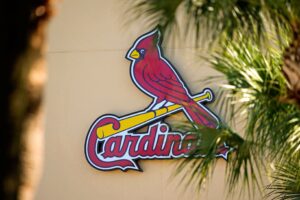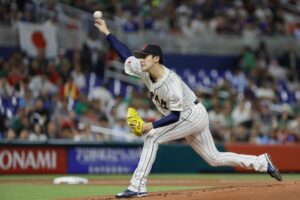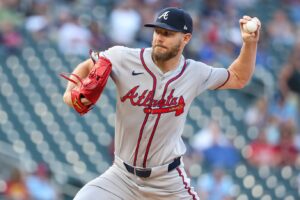Homer Bailey has pitched just 31 MLB innings since 2014 and the workhorse starter is now three years separated from his most recent season of 30+ starts and 200+ IP. He is now 30 years old, signed through 2019 in Cincinnati to the tune of a 6 year/$105M contract, and is hopping into a rotation so much younger than he is used to that he probably feels like he spent a century in suspended animation. Remember: former battery mates Johnny Cueto, Mat Latos, and Mike Leake have been traded away. So, what might Homer Bailey’s future with the Cincinnati Reds look like?
Homer Bailey’s Future
The Only Workhorse Left
Between the 2012 and 2013 seasons, Homer Bailey averaged 32.5 starts, 208.5 IP, 6.4 innings per start, a 3.58 ERA, a 1.18 WHIP, 2.3 BB/9, and 7.9 K/9. He also averaged one no-hitter per year. That wasn’t the only line that made him valuable. In 2014, he was averaging 6.1 innings pitched per outing, with a 3.71 ERA and 1.23 WHIP, and was on pace to finish with 31.5 starts and 197.5 innings pitched before his season was cut short in August.
Bailey also showed nice signs of quality and durability at ages 23, 24, and 25 by averaging 5.80 innings per start, with a 4.47 ERA, and 1.37 WHIP. The 2004 seventh-overall draft pick just hasn’t been able to take the field the last two seasons. Now, he is the elder statesman on a pitching staff where the average starter and high-leverage reliever is 24.9 years old.
Cueto, Latos, Leake, Bronson Arroyo, Aroldis Chapman, Todd Frazier, Jay Bruce, Jonathan Broxton, and Marlon Byrd are all gone. Brandon Phillips is on his way out, Devin Mesoraco has also been injury-riddled since 2014, and all that remain from the Homer Bailey golden days are Joey Votto and Zack Cozart.
Homer Bailey was once a proud center piece for perennial playoff contenders. Now he is fighting for his future in professional baseball.
What His Injury History Means
The massive amount of time missed has left Bailey way behind as the big-league Reds continue to add young prospects to the rotation and the high-leverage bullpen roles. Bailey signed that deal in 2014 as a 28-year-old who appeared to have a lot of miles left. Now, he is 30 years old and clawing his way back to the mound in Great American Ballpark.
He pitched 28 innings across eight starts with Pensacola and Louisville in recovery and, while his numbers with the Reds don’t look great this year at 23 innings pitched in six starts with a 6.65 ERA and 1.83 WHIP, he did have three outings in which he produced a 1.62 ERA, 1.08 WHIP, and 12.4 K/9 in 5.6 innings per start.
In other good news, Bailey’s two main pitches throughout his career have been his fastball, which ranges from 86.9-98.8 mph and averages at 93.2, and his slider, which ranges from 69.8 to 94.8 mph and averages at 86.8. He throws the fastball 50% of the time and the slider 16% of the time.
This season, he has been slinging his fastball at 93.2 mph on average, which is his exact career average, and he has actually been throwing his slider faster than he typically has in years past (87.3 mph). Bailey has at least looked like the guy he was from 2012-2014. So what hints does this give for his future in baseball and with the Reds?
This complete picture won’t be clear for a while. The first step is Bailey being able to throw his pitches with the same velocity, action, command, and frequency that he could at his peak. The second step is being able to make consistent starts and consistently go deep into games.
Third, Bailey must begin performing at a high level in these starts. Finally, he must avoid another devastating injury. We have already seen Bailey throw his pitches with similar velocity, and we have at least seen him make three good starts out of his six this year. Only time will tell if he can be the same guy.
With recent flashes of his old self, it makes perfect sense that he could have some more seasons of 32-33 starts and 200+ IP. There may be a few frustrating setbacks along the way, however.
Does the Contract Make Him Immovable?
Despite his lack of mound time, Homer Bailey’s current contract is making him a very rich man. He is set to make $18 million this year, $19 million in 2017, $21 million in 2018, and $23 million in 2019. That is $81 million left on his deal, with an average of $20.25 million per year. He also has an option in 2020 that could either see the Reds pay him a $5 million buyout or exercise the option for $25 million.
This is a different situation than that of Joey Votto, who is signed through 2023 and is slated to take home $192 million for the next eight years at an average of $24 million per year. The first difference is that Votto has a full no-trade clause, while Bailey does not.
The second difference is that, including the 532 at bats and 155 games played he is on pace for this season, Votto has averaged 488 at bats and 138 games played since 2008.The third difference is that Votto is a former Gold Glove winner, All-Star, and MVP who has averaged a WAR of 5.9 in his seven complete seasons.
If a contender decided to go all-in and make a blockbuster deal for Joey Votto in hopes of a World Series run, they would have to take on his massive price tag. Many would do so willingly, since he has maintained every shred of plate discipline, contact hitting, and power hitting that made him so valuable when he inked the deal. With Homer Bailey, too many question marks remain for anyone to rationally take on the $81 million burden.
If Homer Bailey could come back in 2017 or 2018 and toss 200+ innings in 30+ starts with a sub-4.00 ERA and sub-1.30 WHIP, then a window for a transaction would open. He would be owed less total money and he would’ve proven that he is once again durable and over his injuries, and could provide a contender with a workhorse starter.
For now, all the Reds can do is wait. They can’t move him and they certainly can’t give up on him, given his history and contract status. All the organization can do is move forward and hope Bailey can pick up the pieces of what was once one of MLB’s most reliable starters.
Main Photo:






